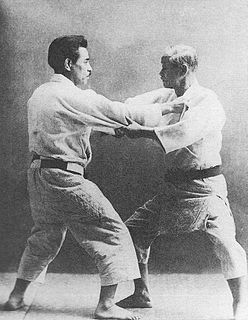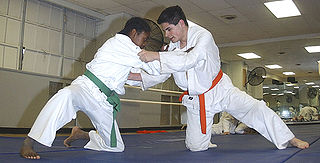 W
WJudo is generally categorized as a modern Japanese martial art, which has since evolved into a combat and Olympic sport. The sport was created in 1882 by Jigoro Kano (嘉納治五郎) as a physical, mental, and moral pedagogy in Japan. With its origins coming from jujutsu, judo's most prominent feature is its competitive element, where the objective is to either throw or take down an opponent to the ground, immobilize or otherwise subdue an opponent with a pin, or force an opponent to submit with a joint lock or a choke. Strikes and thrusts by hands and feet as well as weapons defences are a part of judo, but only in pre-arranged forms and are not allowed in judo competition or free practice. It was also referred to as Kanō Jiu-Jitsu until the introduction to the Olympic Games. A judo practitioner is called a "judoka", and the judo uniform is called "judogi".
 W
WJudogi is the formal Japanese name for the traditional uniform used for Judo practice and competition.
 W
WKanō Jigorō was a Japanese educator, athlete, and the founder of Judo. Judo was the first Japanese martial art to gain widespread international recognition, and the first to become an official Olympic sport. Pedagogical innovations attributed to Kanō include the use of black and white belts, and the introduction of dan ranking to show the relative ranking among members of a martial art style. Well-known mottoes attributed to Kanō include "maximum efficiency with minimum effort" and "mutual welfare and benefit".
 W
WKata is a Japanese word meaning "form". It refers to a detailed choreographed pattern of martial arts movements made to be practised alone. It can also be reviewed within groups and in unison when training. It is practised in Japanese martial arts as a way to memorize and perfect the movements being executed. Korean martial arts with Japanese influence use the derived term hyeong and also the term pumsae.
 W
WKosen judo is a variation of the Kodokan judo competitive ruleset that was developed and flourished at the kōtō senmon gakkō (高等専門学校) technical colleges in Japan in the first half of the twentieth century. Kosen judo's rules allow for greater emphasis of ne-waza than typically takes place in competitive judo and it is sometimes regarded as a distinct style of judo.
 W
WIn Judo, improvement and understanding of the art is denoted by a system of rankings split into kyū and dan grades. These are indicated with various systems of coloured belts, with the black belt indicating a practitioner who has attained a certain level of competence.
 W
WUke (受け) is in Japanese martial arts the person who "receives" a technique. The exact role of uke varies between the different arts and often within the art itself depending on the situation. For instance, in aikido, judo kata, and bujinkan ninjutsu, uke initiates an attack against their partner, who then defends, whereas in competition judo, there is no designated uke.